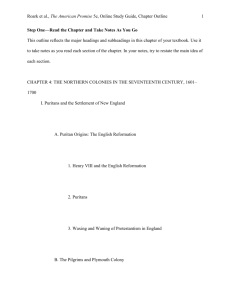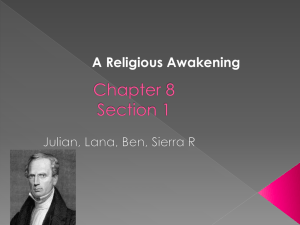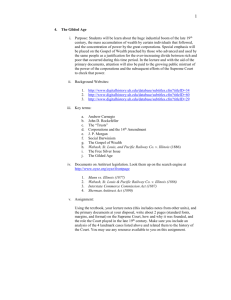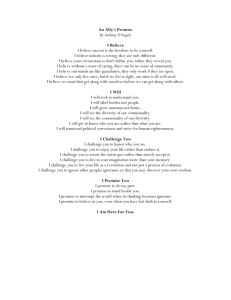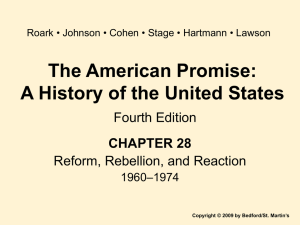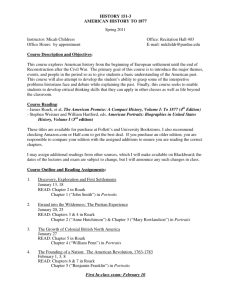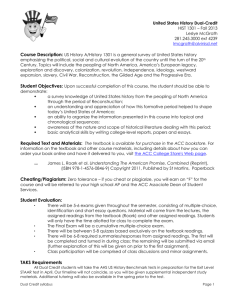Chapter 4
advertisement
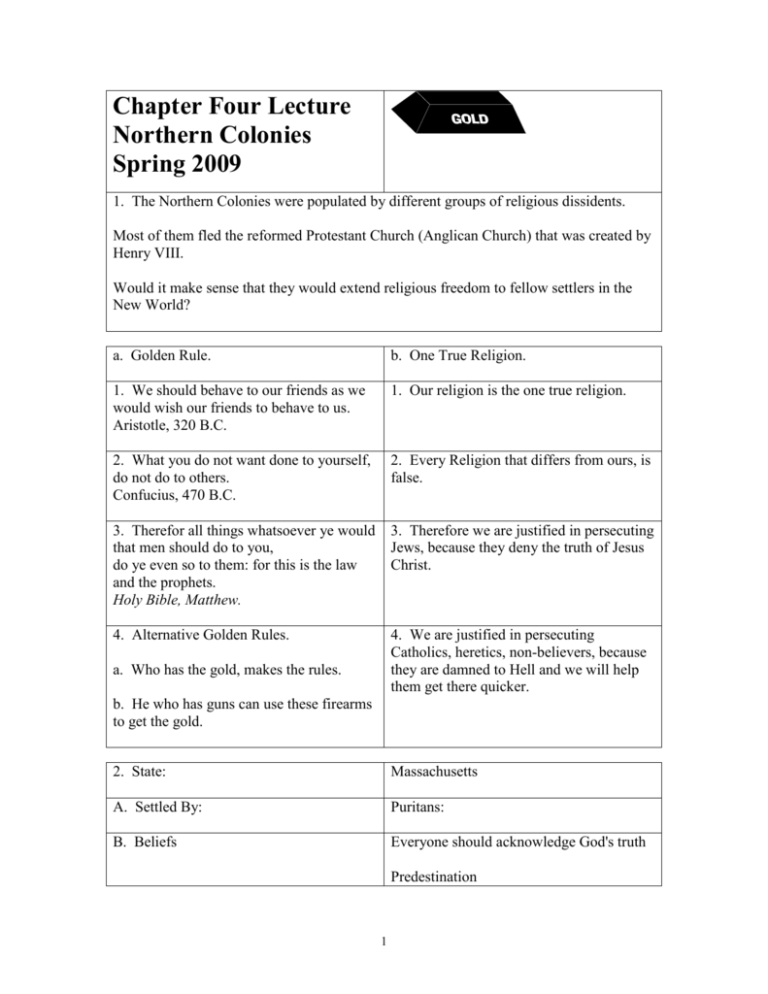
Chapter Four Lecture Northern Colonies Spring 2009 1. The Northern Colonies were populated by different groups of religious dissidents. Most of them fled the reformed Protestant Church (Anglican Church) that was created by Henry VIII. Would it make sense that they would extend religious freedom to fellow settlers in the New World? a. Golden Rule. b. One True Religion. 1. We should behave to our friends as we would wish our friends to behave to us. Aristotle, 320 B.C. 1. Our religion is the one true religion. 2. What you do not want done to yourself, do not do to others. Confucius, 470 B.C. 2. Every Religion that differs from ours, is false. 3. Therefor all things whatsoever ye would that men should do to you, do ye even so to them: for this is the law and the prophets. Holy Bible, Matthew. 3. Therefore we are justified in persecuting Jews, because they deny the truth of Jesus Christ. 4. Alternative Golden Rules. 4. We are justified in persecuting Catholics, heretics, non-believers, because they are damned to Hell and we will help them get there quicker. a. Who has the gold, makes the rules. b. He who has guns can use these firearms to get the gold. 2. State: Massachusetts A. Settled By: Puritans: B. Beliefs Everyone should acknowledge God's truth Predestination 1 Conformity: "Contrary minded men" were asked to leave1 No Christmas or Easter holidays No cards, no dancing C. Kicked Out Roger Williams, 16312 1. Why? He believed that God created and spoke to Native Americans He disagreed that everyone should be forced to attend church service 2. Moved to and Settled Rhode Island Permitted Freedom of Worship D. Kicked Out Anne Hutchinson, 16383 1. Why? She believed that God spoke to women and directly to common people 2. Moved to and Settled Roger William's Rhode Island4 Then New York E. Kicked Out Quakers, 16565 1. Why? Inner Light God spoke directly to each individual6 2. Moved to and Settled Pennsylvania, William Penn 1 James L. Roark, Michael P Johnson, Patricia Cline Cohen, Sarah Stage, Arizona State University, Alan Lawson, and Susan M. Hartmann, The American Promise: A Compact History Third Edition Volume I: To 1877 (Boston, Massachusetts: St. Martin's, 2007), 87. 2 Roark, The American Promise, 78. 3 Roark, The American Promise, 89. 4 Roark, The American Promise, 77 5 Roark, The American Promise, 91 6 Samuel Eliot Morison, Henry Steele Commager, and William E. Leuchtenburg, A Concise History Of The American Republic (New York: Oxford University Press, 1983), 35. 2 F. Kicked Out Pequot and Wampanoag "Indians," 16757 Metacomet-(King Philip)8 1. Why? Land Stealing 2. Moved to and Settled Farther West G. Kicked Out Witches, 1692: 100 accused, 19 executed9 1. Why? Voodoo, Witchcraft Spectural Evidence 2. Moved to and Settled ? 3. State: Chesapeake A. Settled By: Anglicans B. Beliefs Church of England Sunday attendance and religious conformity were "required" of all residents10 C. Kicked Out Catholics Lord Baltimore11 1. Why? Did not acknowledge Martin Luther (Protestant), John Calvin and Henry VIII's religious truths 2. Moved to and Settled Maryland 7 Roark, The American Promise, 97 Roark, The American Promise, 97 9 Roark, The American Promise, 92 10 Roark, The American Promise, 64 11 Roark, The American Promise, 64 8 3 4. State: New York A. Settled By: Dutch (New Amsterdam) B. Beliefs Protestant C. Kicked Out Mormons12 1. Why? polygamy, different interpretations 2. Moved to and Settled Ohio Missouri Illinois Utah Question: Since America began as diverse religious refuges for dissidents who did not want to extend the same privileges to others, how did the New World change them by 1787 and the Bill of Rights, into a society that valued religious toleration and diversity? Modern Progress. Two-thirds of American church goers now believe that there are many different paths to Heaven and alternative reasonable interpretations of the Bible.13 Quakers. Out of the religious ferment of Puritan England came the Society of Friends, commonly known as Quakers. They believed that religious authority rested neither in the Bible nor in a priestly hierarchy but in the Inner Light of Jesus Christ in the soul of every man . . . Since every man had some of God's spirit, all men were brothers and all were equal. Samuel Eliot Morison, Professor of History at Harvard, Henry Steele Commager, Professor of History at Amherst College, and William E. Leuchtenburg, Professor of History at University of North Carolina, A Concise History Of The American Republic (New York: Oxford University Press, 1983), 35. In 1652 the first Quaker missionaries appeared in the English colonies. Severe laws were passed against them in every colony but Rhode Island, and in Boston three were hanged; 12 Joseph Wheelan Invading Mexico: America's Continental Dream And The Mexican War, 1846-1848 (New York: Carroll & Graf Publishers, 2007), 212; Roark, The American Promise, 289, 290. 13 Pew Forum, Religion & Public Life: Landscape Survey (Washington, DC: Pew Forum, 2008. 4 but finally by passive resistance they wore down the authorities and won a grudging toleration. Samuel Eliot Morison, Professor of History at Harvard, Henry Steele Commager, Professor of History at Amherst College, and William E. Leuchtenburg, Professor of History at University of North Carolina, A Concise History Of The American Republic (New York: Oxford University Press, 1983), 35. Mormons. The Mormons' large numbers, insularity, and sharp business practices had aroused the hatred of their Gentile neighbors in Ohio, compelling them to move westward. In western Missouri, the situation was even worse: spiraling mob violence murders, arson, and armed clashes between Mormons and Gentiles prompted Missouri Governor Lillburn Boggs to call out ten thousand militiamen to either drive the Mormons from the state or "exterminate" them. In 1838, the militia massacred eighteen Mormons at Haun's Mill and rounded up Smith and six other church leaders. Convicted of treason, they were sentenced to death. Militia Colonel Alexander Doniphan, who had previously defended Mormons in the courtroom, was ordered to carry out the sentence. Doniphan refused, declaring that it was illegal to court-martial civilians, and executing them would be "cold blooded murder." The Mormon leaders were eventually released. Joseph Wheelan Associated Press reporter, Invading Mexico: America's Continental Dream And The Mexican War, 1846-1848 (New York: Carroll & Graf Publishers, 2007), 212. Neighbors branded Mormons heretics and drove Smith and his followers from New York to Ohio, then to Missouri, and finally in 1839 to Nauvoo, Illinois, where they built a prosperous community. But dissenters within the church accused Smith of advocating plural marriage (polygamy). Non-Mormons caught wind of the controversy and eventually arrested Smith and his brother. On June 27, 1844, a mob stormed the jail and shot both men dead. James L. Roark, Emory University, Michael P Johnson, Johns Hopkins University, Patricia Cline Cohen, University of California, Santa Barbara, Sarah Stage, Arizona State University, Alan Lawson, Boston College, and Susan M. Hartmann, Ohio State University, The American Promise: A Compact History Third Edition Volume I: To 1877 (Boston, Massachusetts: St. Martin's, 2007), 289. The embattled church turned to an extraordinary new leader, Brigham Young, who immediately began to plan a great exodus. In 1846, traveling in 3,700 wagons, 12,000 Mormons made their way to eastern Iowa; the following year they arrived at their new home beside the Great Salt Lake. Young described the region as a barren waste, "the paradise of the lizard, the cricket and the rattlesnake." Within ten year however, the Mormons developed an irrigation system that made the desert bloom. They accomplished the feat through cooperative labor, not the individualistic and competitive enterprise common among most emigrants. Under Young’s stern leadership, the Mormons built a thriving community. James L. Roark, Emory University, Michael P Johnson, Johns Hopkins University, Patricia Cline Cohen, University of California, Santa Barbara, Sarah Stage, Arizona State University, Alan Lawson, Boston College, and Susan M. Hartmann, Ohio State University, The American Promise: A Compact History Third Edition Volume I: To 1877 (Boston, Massachusetts: St. Martin's, 2007), 290. 5 Pew Study. Most Americans agree with the statement that many religions – not just their own – can lead to eternal life. Among those who are affiliated with a religious tradition, seven-inten say many religions can lead to eternal life. This view is shared by a majority of adherents in nearly all religious traditions, including more than half of members of evangelical Protestant churches (57%). Only among Mormons (57%) and Jehovah’s Witnesses (80%) do majorities say that their own religion is the one true faith leading to eternal life. Most Americans also have a non-dogmatic approach when it comes to interpreting the tenets of their own religion. For instance, more than two-thirds of adults affiliated with a religious tradition agree that there is more than one true way to interpret the teachings of their faith, a pattern that occurs in nearly all traditions. The exceptions are Mormons and Jehovah’s Witnesses, 54% and 77% of whom, respectively, say there is only one true way to interpret the teachings of their religion. Pew Forum, Religion & Public Life: Landscape Survey (Washington, DC: Pew Forum, 2008. 6
